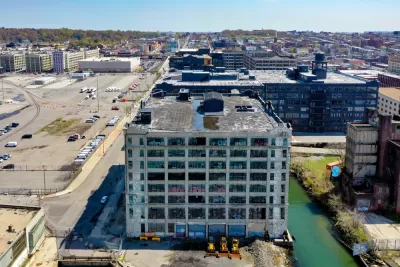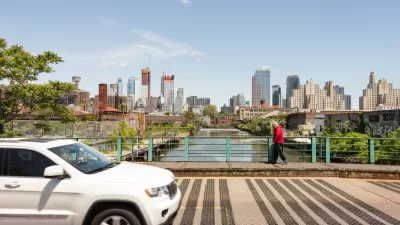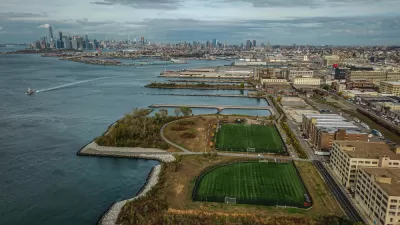Some people oppose commercial development in working-class neighborhoods, fearing gentrification. But if nothing that makes a place more desirable can be built, jobs will become less accessible to those neighborhoods—an obviously absurd result.

Last year, a landowner proposed to rezone some land in Sunset Park (a working-class Brooklyn neighborhood) to permit the construction of restaurants and a hotel. This plan was torpedoed by local politicians because of "Not In My Back Yard" (NIMBY) concerns about gentrification. In particular, rezoning opponents argued that the proposed new businesses would bring high-end retail and high-wage employees to Sunset Park, and that those employees and their customers might want to live in the neighborhood, thus bidding up housing prices enough to displace existing residents.*
If this argument is correct, the only business that would not gentrify a working-class neighborhood is one that pays wages as low as those currently earned by existing residents. If a city consistently applied this view, it would seek to exclude any high-wage jobs in working-class neighborhoods; thus, the residents could never better their economic status without long commutes. It is unclear whether this result would be particularly equitable.
As far as I know, opponents of the rezoning did not take their arguments this far. Instead, some of them argued that the city should somehow create "green" manufacturing jobs. Presumably, these jobs would pay enough to improve the neighborhood standard of living but not enough to attract college-educated professionals. But even if the city could magically create these jobs, it would not prevent demand for housing from increasing.
Why not? Labor markets are citywide. Thus, these manufacturing jobs would attract employees who live in other neighborhoods. Because some of these employees might wish to move near the business to shorten their commutes, even the most politically popular employer would raise demand for housing in the neighborhood, and thus create some risk of rising rents. So if the only truly equitable policy is the one that reduces demand for housing as much as possible, all jobs should be kept as far away as possible from working-class neighborhoods—an obviously absurd result.
The city could try to prevent displacement by conditioning the rezoning on anti-gentrification safeguards. For example, city law could provide that to receive the rezonings necessary to locate in a working-class neighborhood, an employer must promise to prevent displacement by subsidizing lower-income housing in the neighborhood. But if no such restrictions exist in suburbs, that employer will find it more profitable to move its business to the suburbs (or to a more affluent city neighborhood not subject to the policy). Unless capital is extremely immobile, the city's restrictions will also reduce the number of jobs in working-class urban neighborhoods.
The basic idea underlying the objections to the Sunset Park rezoning is: don't do anything that might make the neighborhood more desirable to anyone. Despite its obvious demand-suppressing benefits, this argument seems to me to lead to absurd results.
*Because of the decline in demand for urban life caused by rising murder rates, COVID-19 and the related growth of telecommuting, it is not clear to me that gentrification is likely to happen anywhere in New York over the next few years. But for the purposes of this article, I will assume that it is early 2020 and that arguments about gentrification may still be made in good faith.

Manufactured Crisis: Losing the Nation’s Largest Source of Unsubsidized Affordable Housing
Manufactured housing communities have long been an affordable housing option for millions of people living in the U.S., but that affordability is disappearing rapidly. How did we get here?

Americans May Be Stuck — But Why?
Americans are moving a lot less than they once did, and that is a problem. While Yoni Applebaum, in his highly-publicized article Stuck, gets the reasons badly wrong, it's still important to ask: why are we moving so much less than before?

Using Old Oil and Gas Wells for Green Energy Storage
Penn State researchers have found that repurposing abandoned oil and gas wells for geothermal-assisted compressed-air energy storage can boost efficiency, reduce environmental risks, and support clean energy and job transitions.

Greening Oakland’s School Grounds
With help from community partners like the Trust for Public Land, Oakland Unified School District is turning barren, asphalt-covered schoolyards into vibrant, green spaces that support outdoor learning, play, and student well-being.

California Governor Suspends CEQA Reviews for Utilities in Fire Areas
Utility restoration efforts in areas affected by the January wildfires in Los Angeles will be exempt from environmental regulations to speed up the rebuilding of essential infrastructure.

Native American Communities Prepare to Lead on Environmental Stewardship
In the face of federal threats to public lands and conservation efforts, indigenous groups continue to model nature-centered conservation efforts.
Urban Design for Planners 1: Software Tools
This six-course series explores essential urban design concepts using open source software and equips planners with the tools they need to participate fully in the urban design process.
Planning for Universal Design
Learn the tools for implementing Universal Design in planning regulations.
Heyer Gruel & Associates PA
City of Moreno Valley
Institute for Housing and Urban Development Studies (IHS)
City of Grandview
Harvard GSD Executive Education
Salt Lake City
NYU Wagner Graduate School of Public Service
City of Cambridge, Maryland





























